| Srl | Item |
| 1 |
ID:
148797
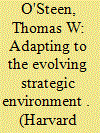

|
|
|
| 2 |
ID:
101225
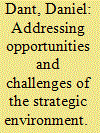

|
|
|
| 3 |
ID:
014099


|
|
|
|
|
| Publication |
1992.
|
| Description |
207-218
|
|
|
|
|
|
|
|
|
|
|
|
|
|
|
|
| 4 |
ID:
014204
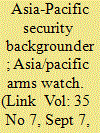

|
|
|
|
|
| Publication |
Sept 7, 1992.
|
| Description |
23-29
|
|
|
|
|
|
|
|
|
|
|
|
|
|
|
|
| 5 |
ID:
132185
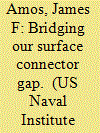

|
|
|
|
|
| Publication |
2014.
|
| Summary/Abstract |
In a new strategic environment, the Marines' ability to expeditiously get people and equipment ashore may be more important than ever. Emerging platforms and technologies promise to be game-changers.
|
|
|
|
|
|
|
|
|
|
|
|
|
|
|
|
| 6 |
ID:
151995


|
|
|
|
|
| Summary/Abstract |
This article analyses two security challenges facing the Royal Cambodian Government (RGC) and the Cambodian Defence Organization at the strategic level for the next decade. The first obvious challenge relates to the stalemated territorial dispute along the Cambodia–Thailand border, particularly the question of ownership of the Preah Vihear (called PhraViharn in Thailand) temple and its surrounding area since October 2008. Bilateral talks to manage the crisis and dispute failed, and the same happened to mediation and peacekeeping efforts by the Association of Southeast Asian Nations (ASEAN) in general and Indonesia in particular. This is considered to be a top security challenge for Cambodia’s national security and drives the military forces’ capability adjustment. The second challenge arises from the overlapping maritime boundary dispute with Thailand in an area which is believed to contain significant oil and natural gas reserves. The article will focus on the nature of the current border conflict with Thailand and its implications for the Cambodian Defence Organization given its limited budget and capability. This article argues that these two key security factors have significantly underpinned Cambodia’s strategic environment and have greatly impacted upon and shaped Cambodia’s reform agenda, defence posture and international engagements. It is also argued the conflict severely tested the regional organization ASEAN and Indonesia as its Chair.
|
|
|
|
|
|
|
|
|
|
|
|
|
|
|
|
| 7 |
ID:
132004
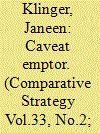

|
|
|
|
|
| Publication |
2014.
|
| Summary/Abstract |
Although intuitively social science has much to contribute to strategy, this article examines the difficulty for strategists doing so. To illustrate the difficulty, the article draws on two social science theories that provided conceptual frameworks for U.S. strategy in the 1960s: deterrence/coercion theory and modernization theory. The article also draws on the cases of Project Camelot in the 1960s and the recent use of human terrain teams to illustrate the difficulty encountered by the military when it tries to use social scientists operationally.
|
|
|
|
|
|
|
|
|
|
|
|
|
|
|
|
| 8 |
ID:
176951
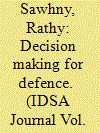

|
|
|
| 9 |
ID:
140821
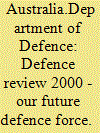

|
|
|
|
|
| Publication |
Australia, Defence Publishing Service, 2000.
|
| Description |
xii, 80p.pbk
|
|
|
|
|
|
|
|
|
|
|
|
Copies: C:1/I:0,R:0,Q:0
Circulation
| Accession# | Call# | Current Location | Status | Policy | Location |
| 043789 | 355.00994/AUS 043789 | Main | On Shelf | General | |
|
|
|
|
| 10 |
ID:
156479
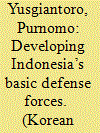

|
|
|
|
|
| Summary/Abstract |
The national resources of Indonesia have a major influence in developing the
nation’s basic defense forces. The state’s capacity to provide budgetary and human
resources is a major determining factor in building the nation’s basic defense
forces. Indonesia is currently not able to leapfrog into the development of ideal
defense forces directly due to constraints on national resources. Thus, the first
step is to focus on developing basic defense forces until the national resources
are sufficiently able to support the development of ideal defense forces. Basic
defense forces should be able to counteract not only fundamental threats (e.g. open
warfare), but also increasingly non-traditional threats, current and potential, to the
nation. An assessment of these non-traditional threats, namely terrorism, cyber
attacks, maritime security and internal disturbances, is important in order to design
basic defense forces, and it begins with a look at the dynamics of the strategic
environment that results in changes in the shape and spectrum of threats.
A key geopolitical concern is that the development of basic defense forces
is not meant to bring the region into an arms race situation. Rather, pursuing
multilateralism and building regional security architecture through international
bodies such as ASEAN are crucial to designing basic defense forces to successfully
eliminate non-traditional threats, as these are increasingly racing to the forefront
of not just national, but also regional, security concerns. This paper will explore
how Indonesia builds its basic defense forces with a focus on countering common
non-threat traditional threats. In order to build basic defense forces, the strategic
environment, the state’s budgetary constraints, the progress of regional defense
cooperation and the anatomy of common threats must be understood first.
|
|
|
|
|
|
|
|
|
|
|
|
|
|
|
|
| 11 |
ID:
132322


|
|
|
|
|
| Publication |
2014.
|
| Summary/Abstract |
The phenomenon of suicide attacks has dramatically expanded over the last twenty years, rising from no events in 1980 to a total of 1,398 events by 2008. A prominent theory has argued that suicide attacks are a coercive strategy aimed at ending foreign military occupation by democracies. Yet these conclusions are based on a research design that is affected by selection bias and that fails to distinguish foreign occupations from cases of groups seeking independence or autonomy, which we term domestic occupations. Analyzing an original data set that distinguishes the different types of occupation, we find that only foreign occupations have a strong and consistent effect on the incidence of suicide attacks. The reason, we argue, is that suicide attacks only become cost effective when targets are both hardened and accessible, a strategic environment that is more common to civil wars and foreign occupations than to domestic occupations.
|
|
|
|
|
|
|
|
|
|
|
|
|
|
|
|
| 12 |
ID:
101656
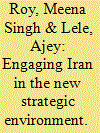

|
|
|
|
|
| Publication |
2011.
|
| Summary/Abstract |
In recent years, Iran has come to acquire a significant place in the West Asian region with the ability to influence regional politics. For India, relations with Iran are vital. In the changed strategic environment, both India and Iran have been working towards improving their bilateral relations. However, there are several challenges, especially for India, in this regard. If the Iran-US confrontation intensifies, for example, India may find it difficult to pursue a smooth relationship with Iran. This article looks at various facets of India-Iran relations and examines the opportunities and challenges that lie ahead.
|
|
|
|
|
|
|
|
|
|
|
|
|
|
|
|
| 13 |
ID:
137623
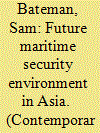

|
|
|
|
|
| Summary/Abstract |
This article adopts a risk assessment approach identifying the maritime threats and challenges that might confront Asia over the next decade. It addresses the evolving strategic environment, shifts in the maritime balance of power and the likelihood and impact of particular threats in the maritime domain. Issues considered include: the consequences of maritime sovereignty disputes; developments in regional naval forces; increased exploitation of marine resources, both living and non-living; and trends in illegal activity at sea. Three scenarios for the future maritime security environment are identified along with the possibility of “strategic shocks” that reflect inherent uncertainty in attempting predictions of the future. The paper concludes with possible measures to mitigate the risks of the threats
|
|
|
|
|
|
|
|
|
|
|
|
|
|
|
|
| 14 |
ID:
012080


|
|
|
|
|
| Publication |
May 1997.
|
| Description |
191-203
|
|
|
|
|
|
|
|
|
|
|
|
|
|
|
|
| 15 |
ID:
007051


|
|
|
|
|
| Publication |
July 2000.
|
| Description |
42-45
|
|
|
|
|
|
|
|
|
|
|
|
|
|
|
|
| 16 |
ID:
100967
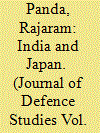

|
|
|
|
|
| Publication |
2010.
|
| Summary/Abstract |
The strategic environment of the world, particularly in Asia, is in a state of dramatic flux. The overwhelming economic and military presence of the United States in Asia is on the wane. China is a rising power, both economically and militarily, and its power projection capabilities are causing concern amongst its neighbours. Though the United States is a declining power, China is not the logical successor, not at least in the near term. These developments have led to realignment of power equations between countries in Asia. In this unfolding strategic landscape, India and Japan, two important players in Asia, are exploring the strategic dimension of their relationships. While growth momentum in the economic domain is not at the desired level, the institutional political structure provides the platform for honing the potentials to their mutual benefits. As a result, a great deal of commonalities is now visible in strengthening bilateral ties in political, economic and security fields. The present paper makes an attempt to evaluate and examine this dimension of the bilateral relationship and the economic dimension that compliments this. The author argues that the developments in the bilateral relations in all fronts suggest that in the coming decade, India-Japan bilateral ties will play critical role in stabilizing the emergence of the new Asian order, in which India, Japan and China can be responsible stakeholders.
|
|
|
|
|
|
|
|
|
|
|
|
|
|
|
|
| 17 |
ID:
128437
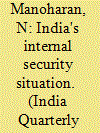

|
|
|
|
|
| Publication |
2013.
|
| Summary/Abstract |
Challenges to internal security of India are numerous. The extent and scope of threats are complex, varied and vast. No other country in the world confronts so many threats, with so much intensity, at the same time. Overall, more than 50 per cent of India is said to be affected by one or the other of these threats, which are not just 'law and order' problems. They have increasing external dimension falsifying conventional wisdom that internal security threats are caused mainly by internal sources. They threaten the body politic like a 'cancer'. The state of poor internal security situation is not because of India's unfavourable strategic environment but also due to weak internal security mechanism, especially its criminal justice system. In this context, the article argues that if appropriate actions are not taken, the threats may result in the gradual degradation of the Indian State. It suggests renewed set of policies and mechanisms in political, economic, socio-cultural, military and diplomatic arena.
|
|
|
|
|
|
|
|
|
|
|
|
|
|
|
|
| 18 |
ID:
010923


|
|
|
|
|
| Publication |
1994.
|
| Description |
1-17
|
|
|
|
|
|
|
|
|
|
|
|
|
|
|
|
| 19 |
ID:
064029


|
|
|
| 20 |
ID:
061253
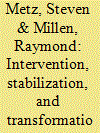

|
|
|